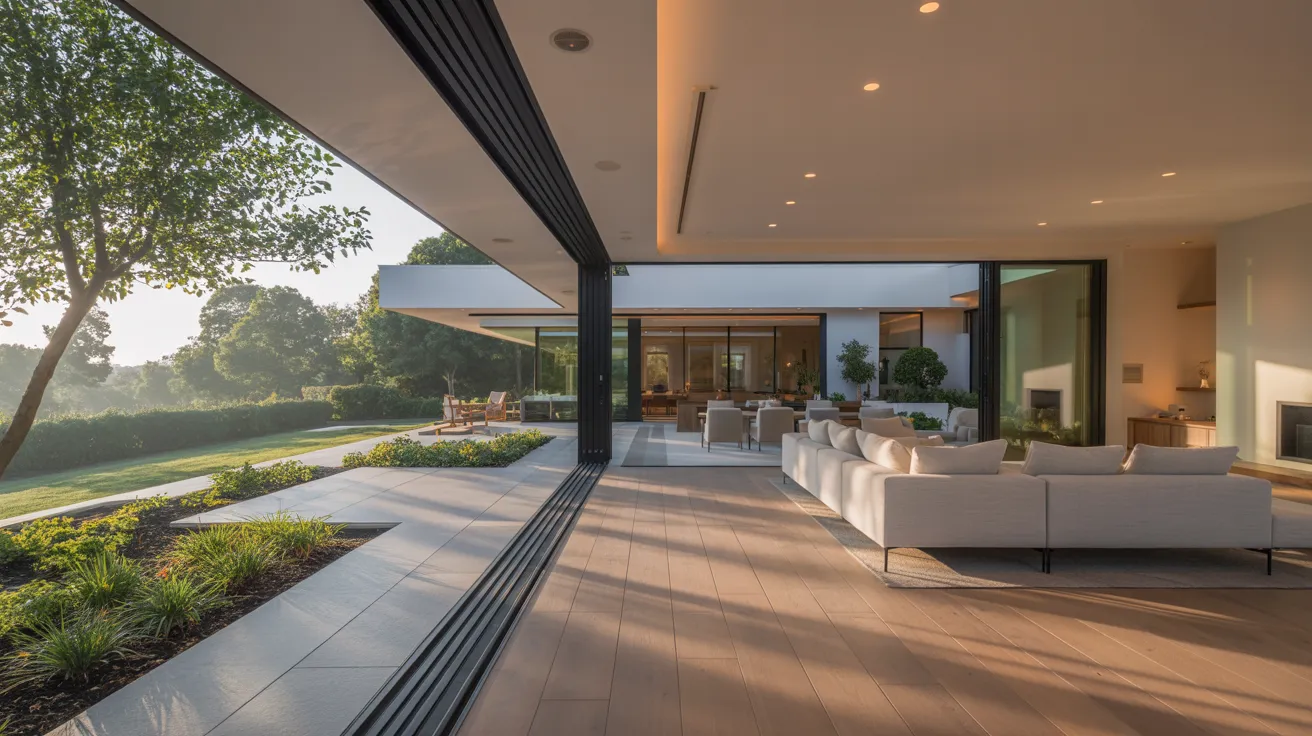You'll notice that premier architect projects in Brookhaven, Atlanta, and Decatur highlight sustainable mixed-use developments, inventive modern homes, and sensitive historic preservation. Look for refined materials in open-plan spaces, thoughtful repurposing of historic industrial spaces, and eco-friendly elements such as native landscaping and solar installations. Acclaimed commercial and community buildings stand out for material innovation, daylighting, and integration with their communities. You'll find a remarkable combination of technical expertise and design vision—look closer to understand how each project sets new benchmarks.

Key Takeaways
Modern Residential Marvels in the Heart of Decatur
In what ways do contemporary architects redefine residential living in Decatur? You'll notice a noticeable movement toward open floorplans that enhance spatial flow and natural light. By doing away with traditional barriers, you establish multifunctional living areas that promote both connectivity and privacy. Architects incorporate minimalist interiors, selecting refined materials like smooth concrete, glass, and natural wood. You'll see built-in storage solutions and integrated lighting, which decrease visual clutter and enhance clean lines. Large windows and sliding doors blur boundaries between inside and out, creating a seamless connection with landscaped courtyards or patios. Every detail, from flush cabinetry to concealed hardware, supports a streamlined aesthetic. By prioritizing open floorplans and minimalist interiors, you create a new residential standard: one that harmonizes efficiency, comfort, and sophisticated design.
Historic Preservation Projects in Atlanta
Countless historic preservation undertakings around Atlanta highlight architects' pledge to restoring the city's notable structures while preserving their original character. You'll find a precise approach when tackling preservation problems such as physical decline, outdated materials, and code compliance. Architects implement specialized restoration approaches—repointing brickwork, recreating period-appropriate windows, and supporting historic facades—to maintain both longevity and authenticity. Every change is carefully documented, from the picking of historically accurate materials to the addition of modern building systems that don't compromise visual integrity. You must also balance energy efficiency with preservation requirements, often requiring creative problem-solving. These endeavors allow Atlanta's storied landmarks—churches, theaters, and antebellum homes—to benefit future generations, merging technical expertise with a sincere respect for architectural heritage and urban context.
Eco-Friendly Architecture in Brookhaven
You'll notice Brookhaven's top projects prioritize green building materials that reduce environmental impact without sacrificing performance. Incorporate energy-saving design solutions to minimize operational costs and enhance occupant comfort. Utilize advanced water conservation methods, making sure every system contributes to long-term sustainability.
Sustainable Building Materials
What distinguishes sustainable architecture in Brookhaven unique is its dedication to cutting-edge green building materials that minimize environmental impact without undermining structural integrity or aesthetics. You'll find architects here strategically select materials like recycled steel, prized for its robustness and reduced embodied energy compared to conventional steel. Recycled steel's durability provides lasting frameworks while promoting eco-conscious design. Moreover, implementing solar panels directly into building envelopes doesn't just generates clean energy but also delivers elegant, modern rooflines. You gain from high-performance insulation and responsibly sourced wood, each picked for low toxicity and sustainable qualities. When you focus on these innovative materials, you help design spaces that look sophisticated and deliver outstanding results, all while reducing your carbon footprint and guaranteeing your project meets the highest sustainability standards.
Energy-Efficient Design Solutions
When it comes to material selection and energy efficiency, design solutions shape sustainable architecture in Brookhaven by maximizing efficiency throughout the process. You'll want to prioritize solar integration, strategically positioning photovoltaic panels to ensure maximum power generation without compromising the building's form. Position windows and living spaces to harness natural daylight, decreasing reliance on artificial lighting. Utilize deep roof overhangs and fixed shading devices to control heat gain. With passive cooling strategies, like cross-ventilation, thermal mass placement, and operable clerestory windows, you'll achieve interior comfort while limiting mechanical cooling demands. Include high-performance insulation and airtight building envelopes to prevent thermal bridging and energy loss. Every detail, from the positioning of windows to the implementation of advanced HVAC zoning, helps achieve a holistic, energy-efficient outcome tailored to Brookhaven's climate.
Water Management Approaches
Although Brookhaven's precipitation levels change across seasons, comprehensive water conservation methods remain essential for eco-friendly architecture. You should focus on rainwater harvesting systems, which capture runoff from roofs and retain it for landscape maintenance or other non-drinking purposes. Install cisterns, permeable pavers, and bioswales to direct and purify stormwater, reducing both runoff and demand on municipal supplies. Water-wise garden design further minimizes water needs—substitute traditional turf with drought-tolerant native species, organic ground cover, and efficient drip irrigation. Pick hardscape materials that promote water absorption rather than runoff. Evaluate low-flow appliances and efficient plumbing fixtures throughout the project. By integrating these features, you'll create buildings that preserve Brookhaven's natural hydrology while attaining long-term sustainability through reduced consumption and thoughtful property maintenance.
Distinguished Commercial Properties
Even as the commercial sector calls for both utility and visual impact, award-winning spaces differentiate themselves through cutting-edge use of components, spatial planning, and sustainable practices. When you walk into such a building, you right away notice how architectural landscaping enhance the architecture, directing movement and creating natural indoor-outdoor transition. Every component, from native plant palettes to porous hardscaping, is picked to boost not just curb appeal but also sustainability. Inside, outstanding interior design maximizes ambient lighting, adaptable spaces, and acoustical solutions to boost performance and satisfaction. You'll find that material selections emphasize resilience and low environmental impact, while color palettes and surfaces strengthen brand presence. This precise attention to detail creates commercial environments that are both visually engaging and operationally efficient, creating new industry references.
Strategic Building Transformation Projects
When professionals undertake adaptive reuse, they transform outdated structures into practical, high-performance environments that honor a building's original character. You can see this process in projects that transform old commercial buildings, manufacturing facilities, or historic venues into dynamic commercial spaces, art venues, or living quarters. Adaptive reuse demands a careful assessment of current infrastructure, structural soundness, and support systems. You'll need to navigate website code compliance and incorporate modern infrastructure components without diminishing the historic fabric. Detailing becomes essential—consider exposed brick paired with sleek glazing or restored timber beams supporting open-plan workspaces. Through intelligent space transformation, you maximize usable area, upgrade energy performance, and deliver contemporary functionality within a heritage context. The result? Projects that effectively combine sustainability with forward-thinking approaches, enhancing community value and architectural significance.
Innovative Mixed-Use Developments
As cities densify and urban land becomes increasingly scarce, mixed-use developments offer architects with opportunities to design complex, multi-programmatic environments that benefit from synergy. Architects must balance shopping, living, working, and entertainment functions within a single footprint, ensuring seamless circulation and spatial hierarchy. Strategic metropolitan design calls for careful examination of the site context, integrating efficient transportation linkages, pedestrian pathways, and public spaces. Zoning regulations determine essential parameters—height limits, setbacks, parking requirements—that demand inventive design solutions to maximize density without sacrificing livability. You'll incorporate sustainable materials, daylighting strategies, and energy-efficient systems to improve performance and user experience. By focusing on connectivity and accessibility, architects can develop vibrant, resilient communities that accommodate evolving urban needs and advance architectural excellence.
Notable Public and Cultural Landmarks
Beyond the complexities of mixed-use developments, you'll find public and cultural buildings requiring a enhanced sensitivity to local identity, symbolism, and social context. When tackling these projects, evaluate the connection between space, structure, and utility. You must acknowledge the significance of cultural landmarks; they must integrate seamlessly into their urban fabric while maintaining iconic presence. Building materials, natural light, and space planning prove crucial, ensuring visitor flow and accessibility are maximized. Public art installations must be thoughtfully chosen, serving as both anchors and stimulants for community engagement. You must balance contemporary design with respect for historical narratives, creating environments that promote reflection and interaction. In Brookhaven, Atlanta, and Decatur, such buildings ultimately enhance civic pride and strengthen a city's distinctive identity.
Popular Questions
How Can I Find the Perfect Architect for My Project?
While choosing the ideal architect for your project, you'll want to review their background with your preferred architectural style and examine their design portfolio for precision and accuracy. Give preference to architects who prioritize client collaboration—ask about their methodology for including your input in design decisions. Evaluate their attention to detail in previous projects, and verify they provide clear communication about construction phases, timelines, and budgets. This approach helps guarantee a successful and efficient project outcome.
How Long Is the Average Timeline of a Building Design Project?
As you start an architectural project, you'll advance through several distinct project phases, each with a specific timeframe. Usually, the design processes—including conceptual design, schematic design, and design development—span three to six months, based on complexity. The documentation phase needs a further two to four months. Permit acquisition varies, often lasting one to three months. The building process can last six months to twelve months or longer. Maintain close communication with your architect to make sure each phase aligns with your project's requirements and timeline.
What's the Cost of Architectural Services in Atlanta?
If you want to get started with your project, keep in mind that an Atlanta architect usually runs 8-15% of your overall construction or renovation expenses. The cost varies based on architectural approaches, project intricacy, and the level of detail you require. For a renovation, expect to pay anywhere from $5,000 for basic services to over $50,000 for premium projects. Make sure to discuss project details and expectations at the beginning to prevent surprises.
Which Permits Are Required Before Starting Construction
Before beginning construction, you'll need to obtain various permits. Usually, it's required to secure a building permit, which confirms your plans comply with local building codes and zoning regulations. Based on your project's scope, you may also require mechanical, electrical, and plumbing permits. Be sure to provide detailed architectural drawings for approval. Checking your design meets zoning requirements, including setbacks and height restrictions, prevents delays or expensive changes in your construction timeline.
Do Architects Offer Interior Design Services Also?
Architects can definitely support interior design. You'll get value from their exactitude and creative perspective, guaranteeing interior aesthetics integrate perfectly with the building's structure. When you collaborate with an architect, you establish design synergy between structural elements and interior spaces. They'll select materials, lighting, and finishes, coordinating every detail for a unified appearance. By incorporating interior design in the initial stages, you perfect both function and beauty throughout your space.
Wrapping Up
As you explore Decatur, Brookhaven, and Atlanta, you'll notice how leading designers merge form and function—over 60% of Atlanta's modern constructions feature sustainable design elements. There's meticulous attention to detail in each mixed-use project and renovation. From protecting architectural heritage or creating modern marvels, these projects push boundaries and set new standards. As you explore these areas, you're witnessing a city transformed through creative design, professional skill, and architectural innovation.
 Patrick Renna Then & Now!
Patrick Renna Then & Now! Jurnee Smollett Then & Now!
Jurnee Smollett Then & Now! Michael C. Maronna Then & Now!
Michael C. Maronna Then & Now! Matilda Ledger Then & Now!
Matilda Ledger Then & Now! The Olsen Twins Then & Now!
The Olsen Twins Then & Now!